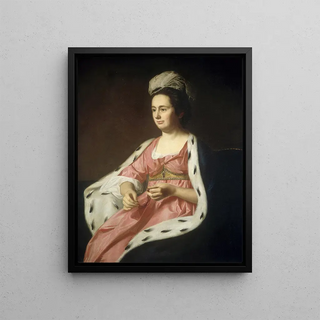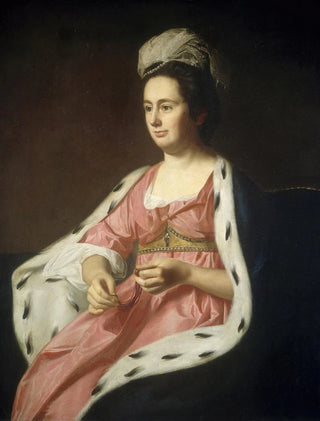Art print | Abigail Smith Babcock Mme Adam Babcock - John Singleton Copley


View from behind

Frame (optional)
The artwork "Abigail Smith Babcock Mme Adam Babcock" by John Singleton Copley is a masterpiece of 18th-century American portraiture. It embodies not only the beauty and elegance of its subject but also the technical skill and stylistic innovation of the artist. Through this painting, Copley transports us into a world where the finesse of details and the depth of emotions meet, thus revealing the complexity of human relationships and social roles of its time. The depiction of Abigail Smith Babcock, wife of Adam Babcock, is not limited to a simple portrait; it is a window into female identity and bourgeois values of New England in the 18th century.
Style and uniqueness of the work
Copley's style is characterized by striking realism and meticulous attention to detail. In "Abigail Smith Babcock," every element, from the fabric of the dress to the facial expression, is treated with remarkable precision. The composition is carefully balanced, highlighting the subject while incorporating symbolic elements that enrich the visual narrative. The colors, both vivid and nuanced, give a vibrant atmosphere to the piece, while light plays a crucial role, accentuating textures and volumes. This painting also stands out for its psychological approach, where the woman's gaze seems to capture a moment of introspection, revealing an uncommon emotional depth for the period. Copley succeeds in transcending simple portraiture by creating a work that invites reflection on the status and condition of women in the society of his time.
The artist and his influence
John Singleton Copley, born in Boston in 1738, is considered one of the greatest portraitists of his era. His career spanned several decades, and he established himself as an essential artist in the American colonial world. Influenced by European masters such as Van Dyck and Reynolds, Copley developed a style that combines realism with narrative sensitivity. His work not only influenced his contemporaries but also left a lasting imprint on future generations of artists.

Matte finish

View from behind

Frame (optional)
The artwork "Abigail Smith Babcock Mme Adam Babcock" by John Singleton Copley is a masterpiece of 18th-century American portraiture. It embodies not only the beauty and elegance of its subject but also the technical skill and stylistic innovation of the artist. Through this painting, Copley transports us into a world where the finesse of details and the depth of emotions meet, thus revealing the complexity of human relationships and social roles of its time. The depiction of Abigail Smith Babcock, wife of Adam Babcock, is not limited to a simple portrait; it is a window into female identity and bourgeois values of New England in the 18th century.
Style and uniqueness of the work
Copley's style is characterized by striking realism and meticulous attention to detail. In "Abigail Smith Babcock," every element, from the fabric of the dress to the facial expression, is treated with remarkable precision. The composition is carefully balanced, highlighting the subject while incorporating symbolic elements that enrich the visual narrative. The colors, both vivid and nuanced, give a vibrant atmosphere to the piece, while light plays a crucial role, accentuating textures and volumes. This painting also stands out for its psychological approach, where the woman's gaze seems to capture a moment of introspection, revealing an uncommon emotional depth for the period. Copley succeeds in transcending simple portraiture by creating a work that invites reflection on the status and condition of women in the society of his time.
The artist and his influence
John Singleton Copley, born in Boston in 1738, is considered one of the greatest portraitists of his era. His career spanned several decades, and he established himself as an essential artist in the American colonial world. Influenced by European masters such as Van Dyck and Reynolds, Copley developed a style that combines realism with narrative sensitivity. His work not only influenced his contemporaries but also left a lasting imprint on future generations of artists.






